String manipulation means writing code to process non-numeric variables. Examples of the string are names, addresses, gender, cities, book titles, alphanumeric characters (@,#,$,%,^,&,*, etc) and more. In Visual Basic 2013, a string is a single unit of data that made up of a series of characters.They include letters, digits, alphanumeric symbols and more. It is treated as the String data type and cannot be manipulated mathematically though it might consist of numbers.
In Visual Basic 2013, strings can be manipulated using the & sign and the + sign, both perform the string concatenation. It means combining two or more smaller strings into larger strings. For example, we can join “Visual”,”Basic” and “2013″ into “Visual Basic 2013″ using “Visual”&”Basic” or “Visual “+”Basic”, as shown in the Examples below:
Private Sub Button1_Click(ByVal sender As System.Object, ByVal e As System.EventArgs) Handles Button1.ClickDim text1, text2, text3, text4 As String text1 = “Visual” text2 = “Basic” text3=”2013″ text4 = text1 + text2+text3 MsgBox (text4) End Sub
The line text4=text1+ text2 + text3 can be replaced by text4=text1 & text2 &text3 and produces the same output. However, if one of the variables is declared as numeric data type, you cannot use the + sign, you can only use the & sign.
The output is shown in Figure 12.1:
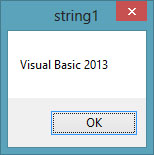
Private Sub Button1_Click(ByVal sender As System.Object, ByVal e As System.EventArgs) Handles Button1.Click Dim text1, text3 as string Dim Text2 As Integer text1 = “Visual” text2=22 text3=text1+text2 MsgBox(text3) End Sub
This code will produce an error because of data mismatch. The error message appears as follows:
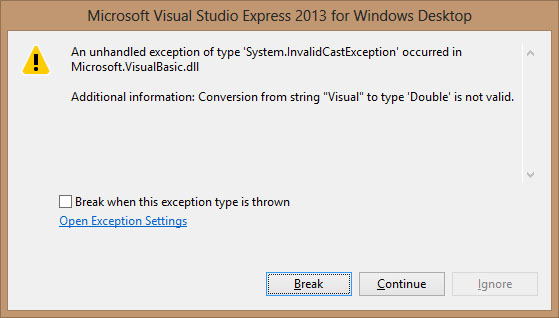
However, using & instead of + will be all right.
Dim text1, text3 as string Dim Text2 As Integer text1 = “Visual” text2=22 text3=text1 & text2 MsgBox(text3)
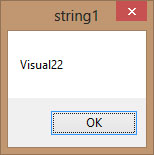
A function is similar to a normal procedure but the main purpose of the function is to accept a certain input and return a value which is passed on to the main program to finish the execution.There are numerous string manipulation functions that are built into Visual Basic 2013.
The Len function returns an integer value which is the length of a phrase or a sentence, including the empty spaces. The syntax is
Len (“Phrase”)
For example,
Len (Visual Basic) = 12 and Len (“welcome to VB tutorial”) = 22
Private Sub Button1_Click(ByVal sender As System.Object, ByVal e As System.EventArgs) Handles Button1.Click Dim MyText as String MyText="Visual Basic 2013" MsgBox(Len(MyText)) End Sub
The output:
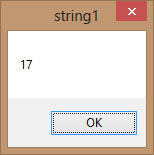
The Right function extracts the right portion of a phrase. The syntax for Visual Basic 6 is
Right (“Phrase”, n)
Where n is the starting position from the right of the phase where the portion of the phrase is going to be extracted. For example,
Right(“Visual Basic”, 4) = asic
However, this syntax is not applicable in Visual Basic 2013. In VB2013, we need to use the following syntax
Microsoft.VisualBasic.Right(“Phrase”,n)
The reason of using the full reference is because many objects have the Right properties so using Right on its own will make it ambiguous to Visual Basic 2013.
Private Sub Button1_Click(ByVal sender As System.Object, ByVal e As System.EventArgs) Handles Button1.Click Dim MyText As String MyText="Visual Basic" MsgBox(Microsoft.VisualBasic.Right(MyText, 4)) End Sub
The above program returns four rightmost characters of the phrase entered into the textbox.
The Output:
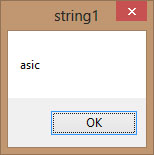
The Left function extracts the left portion of a phrase. The syntax is
Microsoft.VisualBasic.Left(“Phrase”,n)
Where n is the starting position from the left of the phase where the portion of the phrase is will be extracted. For example,
Microsoft.VisualBasic.Left (“Visual Basic”, 4) = Visu .
The Mid function is used to retrieve a part of the text from a given phrase. The syntax of the Mid Function is
Mid(phrase, position,n)
where phrase is the string from which a part of the text is to be retrieved. position is the starting position of the phrase from which the retrieving process begins. n is the number of characters to retrieve.
Example 12.5:Private Sub Button1_Click(sender As Object, e As EventArgs) Handles Button1.Click
Dim myPhrase As String
myPhrase = InputBox("Enter your phrase")
LblPhrase.Text = myPhrase
LblExtract.Text = Mid(myPhrase, 2, 6)
End Sub
* In this example, when the user clicks the button, an input box will pop up prompting the user to enter a phrase. After a phrase is entered and the OK button is pressed, the label will show the extracted text starting from position 2 of the phrase and the number of characters extracted is 6.
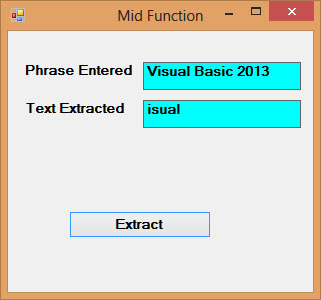
The Trim function trims the empty spaces on both sides of the phrase. The syntax is
Trim(“Phrase”).For example,
Trim (” Visual Basic “) = Visual basicExample 13.4
Private Sub Button1_Click(ByVal sender As System.Object, ByVal e As System.EventArgs) Handles Button1.Click Dim myPhrase As String myPhrase = InputBox(“Enter your phrase”) Label1.Text = Trim(myPhrase) End Sub
The Ltrim function trims the empty spaces of the left portion of the phrase. The syntax is
Ltrim(“Phrase”)
For example,
Ltrim (" Visual Basic 2013")= Visual basic 2013
The Rtrim function trims the empty spaces of the right portion of the phrase. The syntax is
Rtrim(“Phrase”)
For example,
Rtrim (“Visual Basic 2013 “) = Visual Basic 2013
The InStr function looks for a phrase that is embedded within the original phrase and returns the starting position of the embedded phrase. The syntax is
Instr (n, original phase, embedded phrase)
Where n is the position where the Instr function will begin to look for the embedded phrase. For example
Instr(1, “Visual Basic 2013 “,”Basic”)=8
*The function returns a numeric value.
You can write a program code as shown below:
Private Sub Button1_Click(ByVal sender As System.Object, ByVal e As System.EventArgs) Handles Button1.Click Label1.Text = InStr(1, “Visual Basic”, “Basic”) End Sub
The Ucase function converts all the characters of a string to capital letters. On the other hand, the Lcase function converts all the characters of a string to small letters. The syntaxes are
Microsoft.VisualBasic.UCase(Phrase) Microsoft.VisualBasic.LCase(Phrase)
For example,
Microsoft.VisualBasic.Ucase(“Visual Basic”) =VISUAL BASIC Microsoft.VisualBasic.Lcase(“Visual Basic”) =visual basic
The Chr function returns the string that corresponds to an ASCII code while the Asc function converts an ASCII character or symbol to the corresponding ASCII code. ASCII stands for “American Standard Code for Information Interchange”. Altogether there are 255 ASCII codes and as many ASCII characters. Some of the characters may not be displayed as they may represent some actions such as the pressing of a key or produce a beep sound. The syntax of the Chr function is
Chr(charcode)
and the format of the Asc function is
Asc(Character)
The following are some examples:
Chr(65)=A, Chr(122)=z, Chr(37)=% , Asc(“B”)=66, Asc(“&”)=38
* We shall learn more about functions in later lessons
Copyright©2008 Dr.Liew Voon Kiong. All rights reserved |Contact|Privacy Policy